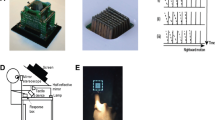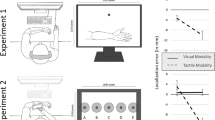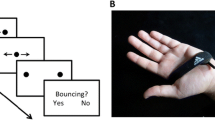Abstract
Multisensory interactions between haptics and vision remain poorly understood. Previous studies have shown that shapes, such as letters of the alphabet, when drawn on the skin, are differently perceived dependent upon which body part is stimulated and on how the stimulated body part, such as the hand, is positioned. Another line of research within this area has investigated multisensory interactions. Tactile perceptions, for example, have the potential to disambiguate visually perceived information. While the former studies focused on explicit reports about tactile perception, the latter studies relied on fully aligned multisensory stimulus dimensions. In this study, we investigated to what extent rotating tactile stimulations on the hand affect directional visual motion judgments implicitly and without any spatial stimulus alignment. We show that directional tactile cues and ambiguous visual motion cues are integrated, thus biasing the judgment of visually perceived motion. We further show that the direction of the tactile influence depends on the position and orientation of the stimulated part of the hand relative to a head-centered frame of reference. Finally, we also show that the time course of the cue integration is very versatile. Overall, the results imply immediate directional cue integration within a head-centered frame of reference.




Similar content being viewed by others
Notes
We report Greenhouse-Geisser-corrected P-values but uncorrected dfs.
Abbreviations
- VMD:
-
Visual motion display
- ms:
-
milliseconds
References
Andersen RA, Buneo CA (2002) Intentional maps in posterior parietal cortex. Annu Rev Neurosci 25:189–220
Andersen RA, Snyder LH, Bradley DC, Xing J (1997) Multimodal representation of space in the posterior parietal cortex and its use in planning movements. Annu Rev Neurosci 20:303–330
Beauchamp MS (2005) See me, hear me, touch me: multisensory integration in lateral occipital-temporal cortex. Curr Opin Neurobiol 15:145–153
Blake R, Sobel KV, James TW (2004) Neural synergy between kinetic vision and touch. Psychol Sci 15:397–402
Bremmer F, Schlack A, Shah NJ, Zafiris O, Kubischik M et al (2001) Polymodal motion processing in posterior parietal and premotor cortex: a human fMRI study strongly implies equivalencies between humans and monkeys. Neuron 29:287–296
Calvert GA, Thesen T (2004) Multisensory integration: methodological approaches and emerging principles in the human brain. J Physiol Paris 98:191–205
Carter O, Konkle T, Wang Q, Hayward V, Moore C (2008) Tactile rivalry demonstrated with an ambiguous apparent-motion quartet. Curr Biol 18:1050–1054
Cohen YE, Andersen RA (2004) Multisensory representations of space in the posterior parietal cortex. In: Calvert GA, Spence C, Stein BE (eds) The handbook of multisensory processes. MIT Press, Cambridge, pp 463–479
Corcoran DWJ (1977) The phenomena of the disembodied eye or is it a matter of personal geography? Percept 6:247–253
Craig JC (2006) Visual motion interferes with tactile motion perception. Percept 35:351–367
Duhamel J-R, Colby CL, Goldberg ME (1998) Ventral intraparietal area of the macaque: congruent visual and somatic response properties. J Neurophysiol 79:126–136
Hartcher-O’Brien J, Gallace A, Krings B, Koppen C, Spence C (2008) When vision ‘extinguishes’ touch in neurologically-normal people: extending the Colavita visual dominance effect. Exp Brain Res 186:643–658
Holmes NP, Spence C (2004) The body schema and multisensory representation(s) of peripersonal space. Cogn Process 5:94–105
Holmes NP, Sanabria D, Calvert GA, Spence C (2006) Multisensory interactions follow the hands across the midline: evidence from a non-spatial visual-tactile congruency task. Brain Res 1077:108–115
James TW, Blake R (2004) Perceiving object motion using vision and touch. Cogn Affect Behav Neurosci 4:201–207
Konkle T, Wang Q, Hayward V, Moore CI (2009) Motion aftereffects transfer between touch and vision. Curr Biol 19:745–750
Làdavas E, Farnè A (2004) Neuropsychological evidence of integrated multisensory representation of space in humans. In: Calvert GA, Spence C, Stein BE (eds) The handbook of multisensory processes. MIT Press, Cambridge, pp 799–817
Lakatos S, Shepard RN (1997) Constraints common to apparent motion in visual, tactile, and auditory space. J Exp Psychol Hum Percept Perform 23:1050–1060
Leinonen L (1980) Functional properties of neurones in the posterior part of area 7 in awake monkey. Acta Physiol Scand 108:301–308
Leinonen L, Hyvärinen J, Nyman G, Linnankoski I (1979) I. Functional properties of neurons in lateral part of associative area 7 in awake monkeys. Exp Brain Res 34:299–320
Macaluso E, Driver J (2001) Spatial attention and crossmodal interactions between vision and touch. Neuropsychologia 39:1304–1316
Maravita A, Spence C, Driver J (2003) Multisensory integration and the body schema: close to hand and within reach. Curr Biol 13:531–539
Mather G, Verstraten F, Anstis SM (1998) The motion aftereffect: a modern perspective. MIT press, Cambridge
Newell FN, Ernst MO, Tjan BS, Bülthoff HH (2001) Viewpoint dependence in visual and haptic object recognition. Psychol Sci 12:37–42
Oldfield SR, Phillips JR (1983) The spatial characteristics of tactile form perception. Perception 12:615–626
Oruc I, Sinnett S, Bischof WF, Soto-Faraco S, Lock K, Kingstone A (2008) The effect of attention on the illusory capture of motion in bimodal stimuli. Brain Res 1242:200–208
Rizzolatti G, Fadiga L, Fogassi L, Gallese V (1997) Enhanced: the space around us. Sci 277:190–191
Sakata H, Shibutani H, Ito Y, Tsurugai K (1986) Parietal cortical neurons responding to rotary movement of visual stimulus in space. Exp Brain Res 61:658–663
Sanabria D, Soto-Faraco S, Spence C (2005) Spatiotemporal interactions between audition and touch depend on hand posture. Exp Brain Res 165:505–514
Sathian K, Prather SC, Zhang M (2004) Visual cortical involvement in normal tactile perception. In: Calvert GA, Spence C, Stein BE (eds) The handbook of multisensory processes. MIT Press, Cambridge, pp 703–709
Sekiyama K (1991) Importance of head axes in perception of cutaneous patterns drawn on vertical body surfaces. Percept Psychophys 49:481–492
Soto-Faraco S, Kingstone A, Spence C (2003) Multisensory contributions to the perception of motion. Neuropsychol 41:1847–1862
Thesen T, Vibell J, Calvert G, Österbauer R (2004) Neuroimaging of multisensory processing in vision, audition, touch, and olfaction. Cogn Process 5:84–93
Tukey JW (1977) Exploratory data analysis. Addison-Wesley, MA
Wijntjes MWA, Volcic R, Pont SC, Koenderink JJ, Kappers AML (2009) Haptic perception disambiguates visual perception of 3D shape. Exp Brain Res 193:639–644
Wohlschläger A (2000) Visual motion priming by invisible actions. Vision Res 40:925–930
Zmigrod S, Spapé M, Hommel B (2009) Intermodal event files: integrating features across vision, audition, taction, and action. Psychol Res 73:674–684
Acknowledgments
The authors acknowledge funding from the Emmy Noether program of the German Research Foundation (grant BU1335/3-1) and would like to thank their colleagues in the Department of Psychology at the University of Würzburg, especially Andrea Kiesel, Albrecht Sebald, Georg Schüssler, and Joachim Hoffmann, and the COBOSLAB team.
Author information
Authors and Affiliations
Corresponding author
Rights and permissions
About this article
Cite this article
Butz, M.V., Thomaschke, R., Linhardt, M.J. et al. Remapping motion across modalities: tactile rotations influence visual motion judgments. Exp Brain Res 207, 1–11 (2010). https://doi.org/10.1007/s00221-010-2420-2
Received:
Accepted:
Published:
Issue Date:
DOI: https://doi.org/10.1007/s00221-010-2420-2




